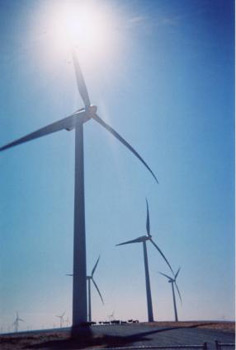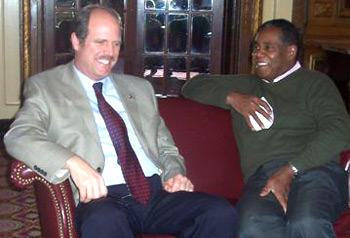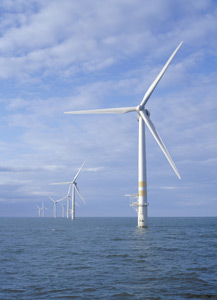Catching the Wind, Part Two
Air Date: Week of July 22, 2005
Our examination of modern wind power continues with a look at the United States. We visit Altamont Pass in California, the place where more birds are killed by wind turbines than anywhere else in the world. But California is also home to High Winds, an energy park that even critics of wind power agree is a model on how to do it right. We also talk with Benjamin Bell from GE Energy, the nation’s largest maker of wind turbines, about advances in the technology of capturing the wind, and why its becoming a big business.
Transcript
CURWOOD: It's Living on Earth. I'm Steve Curwood.
[MUSIC: Rolling Stones "Gimme Shelter" Let it Bleed (Abkco) 1969]
CURWOOD: In December of 1969, the music of the Rolling Stones echoed through the canyons and valleys of Altamont Pass, just east of San Francisco. This was the site of the infamous concert at which a member of the Hells Angels motorcycle gang murdered a man, a symbolic end to the 1960s generation of peace and love.
[SOUND OF WIND TURBINES]
|
(Photo: Chris Ballman)
|
CURWOOD: Today, another sound sweeps through Altamont Pass and some say it's just as ominous.
MILLER: (chuckle) The birds out here are yelling "gimme shelter," you know? The carnage out here that's going on with the birds is a lot more gruesome than what happened at Altamont. CURWOOD: Jeff Miller stands on a high ridge and points to the wind turbines here at Altamont Pass. Below us, scattered across the Diablo Range as far as the eye can see, are nearly 7,000 turbines. [SOUND OF TURBINES SPINNING] CURWOOD: Some are new and big. Most are old and small. Established in the early 1980s, Altamont is the birthplace of wind power in the United States. It's also the wind power industry's worst nightmare. MILLER: If you were going to pick a place to put a wind farm and try to kill as many birds of prey as you could, this would be the place to put it. CURWOOD: Jeff Miller is with the Center for Biodiversity. The group is suing the operators of Altamont Wind Park, claiming their turbines kill more than a thousand birds each year. Among them: protected species including the burrowing owl and the golden eagle. MILLER: Right where we're standing here in the Diablo Range is the highest concentration of golden eagles anywhere in the world. The issue here is, are there things that they can do that are feasible that are within their, you know, reasonable economic costs that the wind power companies can do to reduce birds kills? Absolutely. CURWOOD: Jeff Miller says his group wants operators to reduce bird kills by retiring the most lethal of these "cuisinarts of the air" as critics like to call them. He says remaining turbines should be clustered, their rotors made more visible. Setting aside bird habitat is another option. But there's only so much operators can do. Here's the problem: Altamont Pass is a major bird migration route, a factor that wasn't considered when the wind park was constructed. On the other hand, California urgently needs clean, renewable energy and at Altamont there's certainly plenty of wind. At peak capacity the turbines can produce 580 megawatts. That's enough power to meet the energy needs of nearly 190,000 homes. MILLER: Society's going have to decide. I mean, at Altamont Pass the issue is, are we going to keep producing wind power at Altamont Pass? If the answer is yes, the next question is, is it acceptable to slaughter thousands of rare birds each year? Wind power doesn't have to kill a lot of birds. Appropriately sited, you can have wind power and very little risk to birds. CURWOOD: Altamont is considered the wind power industry's "bad boy." But just a short drive away you can find its "good brother." REARDON: There's a real art to learning to park a car on a wind site. CURWOOD: Brent Reardon is technical manager at the High Winds Energy Center. This state-of-the-art wind park is about thirty miles north of Altamont Pass on the windy slopes of the Montezuma Hills. REARDON: And you can always tell the rookies driving the trucks because the hinges are all bent out on their doors from parking downwind. And you get a 40-mile an hour wind when you open a door and it's unexpected. It just rips it right out of your hand, so... CURWOOD: Ninety huge Danish-made Vesta turbines capture the wind here. These modern three-blade machines, mounted on 300-foot towers, can produce 162 megawatts of electricity. That's enough power for 75,000 homes. So if you do the math, you would need just 228 turbines at High Winds to produce the same amount of electricity as the 7,000 machines at Altamont. CAVANNA: It was impressive for me for several reasons. CURWOOD: Ralph Cavanna directs energy policy for the Natural Resources Defense Council. CAVANNA: The machines are much more productive, you need fewer of them, they are more reliable and they are less intrusive on the landscape and, obviously, less of a threat to birds. CURWOOD: Less of a threat to birds because the towers are taller and their blades are above flight paths. More productive because computers direct the blades to constantly follow the wind. The blades are longer, too, and spin slower, just 16 turns a minute instead of 72 like the old wind turbines. Ralph Cavanna says he's seen the future of wind power in the United States and its name is High Winds. CAVANNA: You shouldn't make your judgments about wind power based on obsolete technology in the first generation. You should be looking at the latest generation, that's what High Winds is; I'm sure we'll do even better. But I found that to be a very hopeful signal about where the industry was going. [SHEEP CALLING BAA, BAA, BAA] CURWOOD: More than 3,000 sheep graze on Ian Anderson's farm. The animals: oblivious to the turbines overhead. The Anderson family has been farming the Montezuma Hills for four generations. Among neat rows of hay and safflower stand 12 giant turbines. Ian Anderson says that leasing his land to those who harvest the wind has become a cash cow. ANDERSON: There's a minimum payment and we do receive, I think, it's 600 dollars per machine so, in my case, there's 12 of them. So, I have a minimum payment of $10,000 a year, which is real helpful to my cash flow. [BAA, BAA] CURWOOD: Ian Anderson believes in the promise of wind energy. So much so, he plans to buy another thousand acres and lease more land to wind turbine operators. If it all works out, Ian Anderson says he'll produce meat and grain for 100,000 people and provide energy for as many as 50,000 homes. ANDERSON: I'm just going to be a strong exporter not only of proteins but also the energy. So that's a really great feeling. The big question will be can they keep these machines running for the 30-year period. What will be the maintenance and repair costs on these and that's an unknown. [SHEEP: BAA, BAA, BAA] MAN: You need to swipe your badge right there and it'll beep and then [BEEP]... CURWOOD: The company that operates the turbines at the Anderson farm in California is headquartered in a huge, ultra-modern building of glass, chrome and high security in Juno Beach, Florida. FLP Energy Spokesman Steve Stengel is optimistic about the long-term viability of their power generators. STENGEL: With proper maintenance there is no reason to believe that those turbines couldn't continue to generate electricity for 25-plus years. CURWOOD: Now, High Winds has been cited by environmentalist activists as the model for doing wind parks right. What did you take into consideration when siting this facility? STENGEL: Well, there was an extensive amount of pre-construction studies that were done that looked at everything from avian issues to plant life issues to cultural resources. We looked at issues related to noise. And so, we did our homework up front to identify any potential impacts or problems that there might be with the site so that we could address those prior to construction. CURWOOD: So, you did all this research. I imagine you found some sticky points. What did you do then to resolve those questions? STENGEL: Well, I think, one of the things to focus on would be issues related to birds. As part of the permit that we received for this facility we agreed to do, for lack of a better term, avian monitoring. And what we do with that is we actually monitor any fatalities that may occur because of the wind farm. And over time, we look at any fatalities and we identify measures that we might be able to implement over time to reduce any of those fatalities. CURWOOD: Now, FPL Energy also operates a number of turbines at Altamont Pass in California. And, as we know, you and other operators there are being sued by the Center for Biological Diversity over the bird kills there, specifically the golden eagle and other raptors. What steps are you taking to lessen the impact on these birds? STENGEL: Well, since we began operating wind turbines in the Altamont area back in 1998, our company and our partners have done a number of things. For instance, we have already taken out of service approximately ten percent of the turbines that we operate in this region. That includes the removal of 169 turbines that we have replaced with 31 new modern turbines. And, in addition to that, we have shut down and have either removed or are in the process of relocating an additional 100 turbines. In addition to that, the turbine owners including FPL energy we have, what is called, an adaptive management plan and, ultimately, this plan calls for re-powering. And, what that is, is taking these older turbines, these turbines that are 10, 15, 20 years old and replacing them with newer modern turbines day like we've talked about previously. CURWOOD: FPL operates something like 6,500 wind turbines in 44 locations in 15 states. That's pretty big. In fact, I think it makes you the largest generator of wind power in the United States. Why did you decide to make this big investment in wind power? STENGEL: First and foremost, there is no emissions with wind power. In addition to that, from an economic sense, the cost of wind power today is much, much more competitive than it was 20 years ago. The technology is better. The machines are more efficient than they were 20 years ago. The other thing that is helping the competitiveness of wind is the high price that we're seeing of natural gas and fuel oil today. So, those are really the primary reasons that we think wind makes sense. CURWOOD: That's dollars, and sense, to a growing number of companies and investors who are throwing big bucks into wind. Federal tax credits and mandates for renewable energy in 18 states and the District of Columbia are energizing the industry. Since 1981, wind power capacity has soared from ten to nearly 7,000 megawatts and is expected to double by the end of the decade. In the past three years alone, more than 400 million dollars has been invested in wind. What once was the province of backyard tinkerers and back-to-earth environmentalists is now a playing field for pinstripe investors like Goldman Sachs and multinationals including Shell, Siemens and General Electric. GE VIDEO: Wind is the world's fastest growing power resource and part of GE Energy's commitment to creative energy solutions for the future.... CURWOOD: GE was showcasing wind power in this promotional video at a recent conference in Boston. And, that's where I caught up with Benjamin Bell, the company's point man on offshore wind turbine sales. For GE, Ben Bell says wind is a growing business. BELL: In 2004, we did a little over one billion dollars globally. And, we anticipate it will be close to two billion in 2006. So I think it's an important, emerging market, you know, essentially double-digit growth rates in the industry. And, GE wants to be some significant part of that. And, globally in the world, is about 50 gigawatts installed. In the United States, we've got close to seven gigawatts. And, right now, if you look at countries like Denmark, 20 percent of their energy is generated by wind where as the United States, it's less than one percent. We've got a long ways to go, but it is growing.
|








